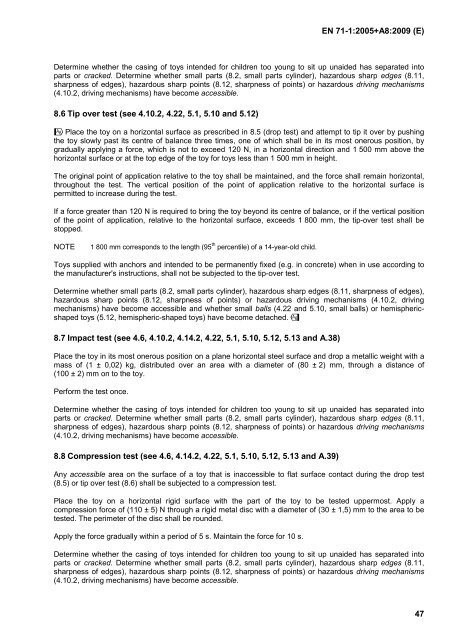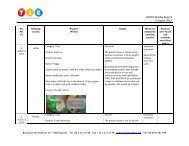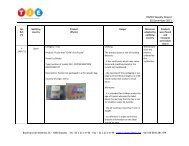Create successful ePaper yourself
Turn your PDF publications into a flip-book with our unique Google optimized e-Paper software.
<strong>EN</strong> <strong>71</strong>-1:<strong>2005+</strong><strong>A8</strong>:2009 (E)<br />
Determine whether the casing of toys intended for children too young to sit up unaided has separated into<br />
parts or cracked. Determine whether small parts (8.2, small parts cylinder), hazardous sharp edges (8.11,<br />
sharpness of edges), hazardous sharp points (8.12, sharpness of points) or hazardous driving mechanisms<br />
(4.10.2, driving mechanisms) have become accessible.<br />
8.6 Tip over test (see 4.10.2, 4.22, 5.1, 5.10 and 5.12)<br />
+Place the toy on a horizontal surface as prescribed in 8.5 (drop test) and attempt to tip it over by pushing<br />
the toy slowly past its centre of balance three times, one of which shall be in its most onerous position, by<br />
gradually applying a force, which is not to exceed 120 N, in a horizontal direction and 1 500 mm above the<br />
horizontal surface or at the top edge of the toy for toys less than 1 500 mm in height.<br />
The original point of application relative to the toy shall be maintained, and the force shall remain horizontal,<br />
throughout the test. The vertical position of the point of application relative to the horizontal surface is<br />
permitted to increase during the test.<br />
If a force greater than 120 N is required to bring the toy beyond its centre of balance, or if the vertical position<br />
of the point of application, relative to the horizontal surface, exceeds 1 800 mm, the tip-over test shall be<br />
stopped.<br />
NOTE 1 800 mm corresponds to the length (95 th percentile) of a 14-year-old child.<br />
Toys supplied with anchors and intended to be permanently fixed (e.g. in concrete) when in use according to<br />
the manufacturer's instructions, shall not be subjected to the tip-over test.<br />
Determine whether small parts (8.2, small parts cylinder), hazardous sharp edges (8.11, sharpness of edges),<br />
hazardous sharp points (8.12, sharpness of points) or hazardous driving mechanisms (4.10.2, driving<br />
mechanisms) have become accessible and whether small balls (4.22 and 5.10, small balls) or hemisphericshaped<br />
toys (5.12, hemispheric-shaped toys) have become detached.,<br />
8.7 Impact test (see 4.6, 4.10.2, 4.14.2, 4.22, 5.1, 5.10, 5.12, 5.13 and A.38)<br />
Place the toy in its most onerous position on a plane horizontal steel surface and drop a metallic weight with a<br />
mass of (1 ± 0,02) kg, distributed over an area with a diameter of (80 ± 2) mm, through a distance of<br />
(100 ± 2) mm on to the toy.<br />
Perform the test once.<br />
Determine whether the casing of toys intended for children too young to sit up unaided has separated into<br />
parts or cracked. Determine whether small parts (8.2, small parts cylinder), hazardous sharp edges (8.11,<br />
sharpness of edges), hazardous sharp points (8.12, sharpness of points) or hazardous driving mechanisms<br />
(4.10.2, driving mechanisms) have become accessible.<br />
8.8 Compression test (see 4.6, 4.14.2, 4.22, 5.1, 5.10, 5.12, 5.13 and A.39)<br />
Any accessible area on the surface of a toy that is inaccessible to flat surface contact during the drop test<br />
(8.5) or tip over test (8.6) shall be subjected to a compression test.<br />
Place the toy on a horizontal rigid surface with the part of the toy to be tested uppermost. Apply a<br />
compression force of (110 ± 5) N through a rigid metal disc with a diameter of (30 ± 1,5) mm to the area to be<br />
tested. The perimeter of the disc shall be rounded.<br />
Apply the force gradually within a period of 5 s. Maintain the force for 10 s.<br />
Determine whether the casing of toys intended for children too young to sit up unaided has separated into<br />
parts or cracked. Determine whether small parts (8.2, small parts cylinder), hazardous sharp edges (8.11,<br />
sharpness of edges), hazardous sharp points (8.12, sharpness of points) or hazardous driving mechanisms<br />
(4.10.2, driving mechanisms) have become accessible.<br />
47








